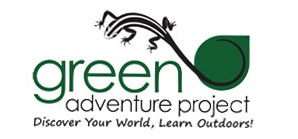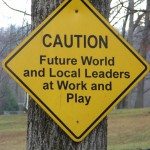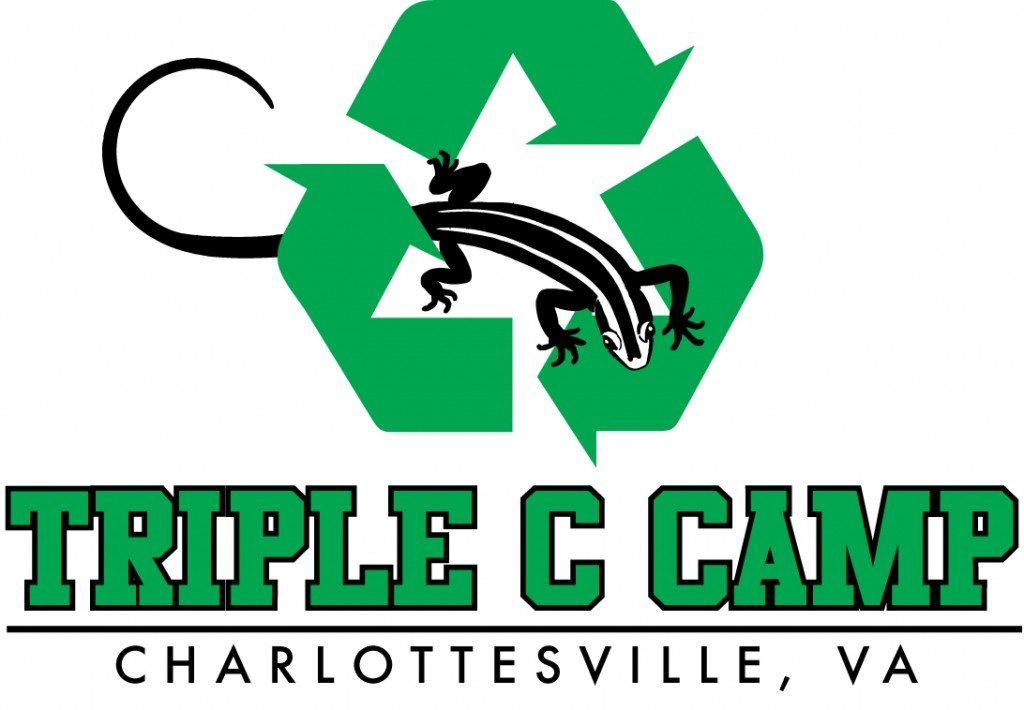A For Profit Goes Green with a 501(c)3
By: “H” Rothenberg Triple C Camp Co-Owner and Director
“I have a new idea for a program!” This is a statement my wife hears from me on a regular basis. We have owned our own private camp in central Virginia since 1999. Having gone through the process of searching for a camp (we toured over 100 camps) finding “the one” and then agreeing to a purchase price with the sellers, getting bank financing, moving our family, and closing on property/business, we thought we were home free.
 As the years went on we always looking to find more ways to generate revenue. In 2001 we built a ropes course to host year round groups and utilize for team building and high climbing during the summer. This was fantastic! We were bringing in much more money than we were spending for the ropes program as my wife and I were facilitating groups with very few part time staff and we were making use of the facility in the spring and the fall. We also did in school team building programs at 20 local Elementary, Middle and High Schools in our area. A decade later we were continuing to look for other revenue streams. We LOVE the Green Movement. We believe in “No child left inside!” We want to make an impact and some $$ along the way.
As the years went on we always looking to find more ways to generate revenue. In 2001 we built a ropes course to host year round groups and utilize for team building and high climbing during the summer. This was fantastic! We were bringing in much more money than we were spending for the ropes program as my wife and I were facilitating groups with very few part time staff and we were making use of the facility in the spring and the fall. We also did in school team building programs at 20 local Elementary, Middle and High Schools in our area. A decade later we were continuing to look for other revenue streams. We LOVE the Green Movement. We believe in “No child left inside!” We want to make an impact and some $$ along the way.
Teachers love the idea of field trips for Environmental Science and it helps the teachers with the standardized testing. However, the money for Science program dollars is a bit harder to come by. The process starts with approaching a teacher to participate in one of our field investigations. These are offered three to five times a year as a teach the teacher opportunity. If the teacher is interested we outline the costs, identify a date and work with the teachers to find sources of funding to help offset the costs. Teachers as well as GAP staff seek funding opportunities reducing student tuition rates. This opportunity and interest from the teachers and community moved us in the direction of forming a not for profit.
In 2008, the Green Movement was in full swing we wanted to make our camp more marketable and cutting edge to our community and the region. The Green Adventure Project (GAP) was born. We made dramatic changes to our property and program regarding going green.
1. We removed all Styrofoam from the camp! We provide lunch for our campers and do not have a commercial dish washer. This was a lot easier than we thought it would be…the parents LOVE IT and the campers are ok with it. They do their own. It teaches responsibility and a great life skill that they got from camp.
a. Replaced with plastic cups and plates. This was very easy and reasonably priced. Plate dividers and sturdy plates from Wal Mart four for $1.00 and they came in great diverse colors. Kids love them!
b. Campers now wash, rinse and sanitize their own plates, cups and cutlery at washing stations behind our dining hall. Easy set up, however after the meal, the kitchen staff have to review every item and very often will wipe the plates clean. We have dry bags and hang them for a few hours, however we usually wind up hand drying…no biggie!
2. Removed water coolers with cone cups.
a. We request that all campers bring a water bottle to camp and carry it with them around camp.
b. We installed more drinking fountains for accessibility to water. This is pretty fantastic. We even have water bottle filling stations outside our well house that say, “Dasani, Aqua fina, and Deer Park” … people ask us all the time if that is “really” those waters outside our well and we leave it to them to decide! 🙂
3. Added rain barrels all around our camp for education and non potable water use.
a. Especially when we have been dry, we use the rain barrel water for plants, animals, washing animals like horses, and other activities where the water can be used safely.
b. Amazing teaching opportunity to what children can do at home or at school and how much water can be harvested and reused from rain.
4. Added composting and a waste reduction program at our meals (eat what you take, and we weigh waste, and give a prize at the end of the week to the least wasteful cabin group). We actually have groups that have zero waste. It’s important that the staff are bought into this for the right reasons. It’s nice to win a contest, however the counselors should not be the campers “garbage disposal” for food the campers don’t eat. Not the right message.
5. We added many recycling bins around camp for all aspects of recycling and some of our oldest campers take the recycling to the local collection site in town once week. The community loves this as when the campers are there…they help people unload their cars of all their recycling.
6. Built garden boxes and grow edibles for our campers while also teaching about growth and sustainability. The campers work in the gardens and get to see the reward on the dining hall buffet.
7. Replaced a rustic 1950’s snow weight damaged building with a state of the art EarthCraft Certified green Educational Center. There are so many amazing aspects of this building. Teaching opportunities EVERYWHERE! A bowling ball Newtons Cradle, loads of reptiles from out of the area that the children can handle(turtle, tortoise, leopard geckos, bearded dragons, etc., trebuchets, a 28X40 animal teaching mural of indigenous animals, and so much more! If you want to invest in a science center, come see ours!
Next, we started speaking to schools in the area to find out if they were interested in partnering for outdoor nature and science programs that would help them teach to the Standardized testing (teachers love that). We found several teachers and a few advocates from the Superintendent’s Office that were very excited about this possibility.
Curriculum is aligned to state standards. We created a program menu for teachers based on topics taught to specific ages. We invested in an Executive Director and Program Director who are experienced in developing curriculum. GAP works with six counties and thirty plus schools at this time.
The biggest obstacle was cost. So, at the same time we approached a local attorney that focused on not for profits. This was a bit intimidating since most Camp Directors don’t have an attorneys back ground and we don’t like attorneys fees. So, we tried to negotiate a set fee for setting up our not for profit. This worked out pretty well.
 We found an attorney that told us it would be no problem to start a not-for profit, however everything would have to be done at “arm’s length”. We needed to keep things from our private business/summer camp (s-corp) completely separate from anything we were doing with the not for profit. So, we set up a separate ledger in Quick Books for my wife who is our CFO and kept all income and expenses for the Green Adventure Project completely separate. We were committed to doing everything the right way, so we followed the attorneys advice. Things we needed to do:
We found an attorney that told us it would be no problem to start a not-for profit, however everything would have to be done at “arm’s length”. We needed to keep things from our private business/summer camp (s-corp) completely separate from anything we were doing with the not for profit. So, we set up a separate ledger in Quick Books for my wife who is our CFO and kept all income and expenses for the Green Adventure Project completely separate. We were committed to doing everything the right way, so we followed the attorneys advice. Things we needed to do:
1. All items of incorporation through the government: the attorney was very helpful with this. The right attorney is the key to make this happen. One that is understanding about starting a new not for profit
2. File for nonprofit status: this was also done by the attorney which presented documents for us to sign
3. Make an adjustments requested by IRS such as:
a. Separate the website for Green Adventure Project
b. Establish a phone line for Green Adventure Project
4. Establish a board of directors and manuals, etc
a. We interviewed camp parents and community folks that have an interest in the Green Movement
b. It is very helpful to have a banker and a local Science Teacher on our Board of Directors
5. Hire an independent real estate appraisal company do a fair market analysis of what rent would be for a program like this in our area. This was a big deal and very expensive, however we needed this to justify our s-corp charging rent to the Green Adventure Project. We are three years in and we have not received rent yet, however the system is in place and the bottom line of the GAP improves.
6. Organize, interview and hire the proper staff to organize the programs and operate fund raising. This is incredibly difficult to find qualified staff that can teach the Green Programs and can write grants and handle all the fund raising. It is a constant challenge for our staff to decide to prioritize program service and revenue to fund raising/grant monies. We made use of the ACA job board and bi-weekly professional jobs available. We got about 30 applications which took time to sift through and then interviewed about 10. All very time consuming, but worth it when you find someone who can run programs and handle administrative work. It’s critical to have staff that will put in extra hours so that after that three day canoe trip and a grant is due the next day, they will still put in the time.
7. Cultivate and develop relationships with granting organizations and public donors. This is also very difficult. When an organization is young, it does not have enough weight under its belt to be credible to some donor organizations, however to serve more participants, we need the funds. It is a bit of a catch 22, however if you are committed to the program service, we believe (and hope) that the funding will come. We also attend meetings and trainings offered by organizations that are connected to funding bodies. Great opportunity to network and build relationships.
 During 2010 Green Adventure Project (GAP) served 500 participants and grew to 1500 in 2011 and will serve 5000+ in 2012. The program numbers are very exciting. The program however barely breaks even financially and will rely on grants and fundraising to stay in the black and pay the staff and the property rent appropriately. It is very difficult for a new 501c3 to get grant money, however we are diligently working toward growing our program base to be more attractive to donors.
During 2010 Green Adventure Project (GAP) served 500 participants and grew to 1500 in 2011 and will serve 5000+ in 2012. The program numbers are very exciting. The program however barely breaks even financially and will rely on grants and fundraising to stay in the black and pay the staff and the property rent appropriately. It is very difficult for a new 501c3 to get grant money, however we are diligently working toward growing our program base to be more attractive to donors.
Our for profit entity benefits from the public relations in the community, bringing more people to the camp property and when it can, GAP will pay rent. GAP benefits from renting space at the camp as the camp already had vehicles for travel programs, supplies, buildings, infrastructure, etc. A not for profit program takes a while to get established. We are serving many more participants then we were previously and the quality of program is FANTASTIC! Areas of challenge include: finding the right part time staff, fund raising and receiving grants.
Any for profit entity that wants to take on operating a not for profit needs to think long and hard about all the up front expenses, staffing and infrastructure of a new organization. This includes strategic planning, organizing with banks, accountants, attorneys and the staff for the private entity.
If the program is quality and the participants are served well there is no better feeling in the world then helping those grow through an experience that they would never have had the opportunity to participate with otherwise.
If you are interested in more information about the Green Adventure Project, or starting a Not for profit, please contact “H” Rothenberg Co-Owner and Director of Triple C Camp in Charlottesville, VA




